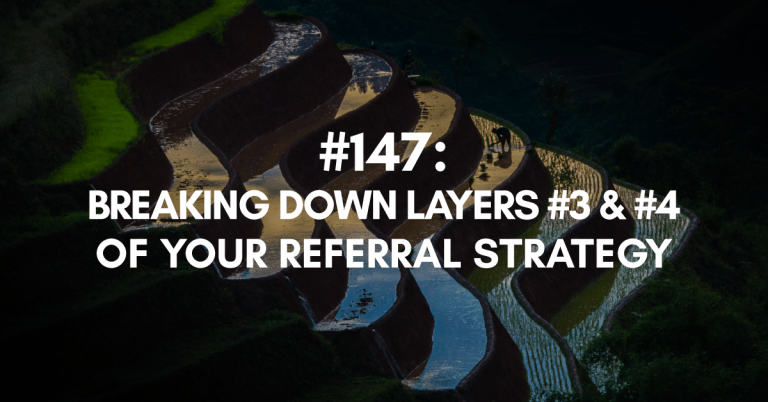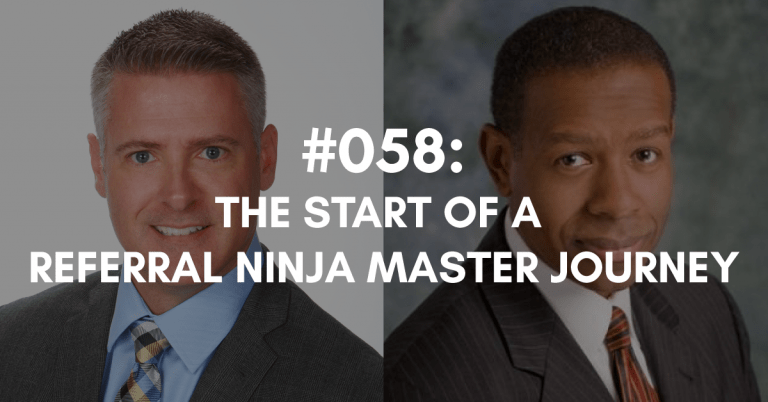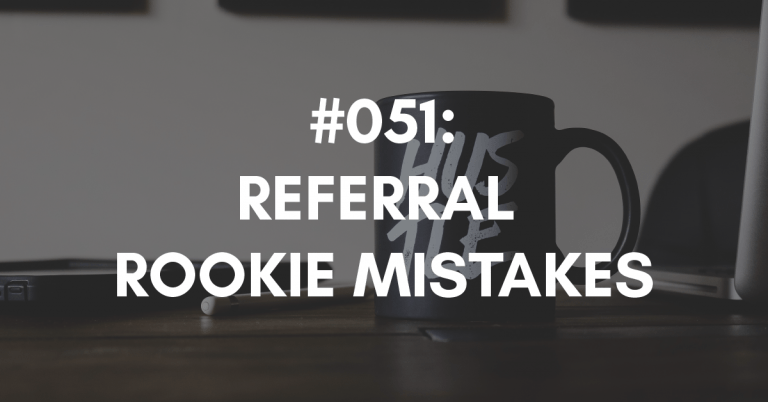Ep #221: Successful Referral Building
New Training Next Week!
Coming up NEXT WEEK is our new, advanced training as I reveal my 3-Part Framework to increase referrals – double, triple or quadruple the referrals you are receiving now. There is a short form to complete to get your invite and the deadline to submit it is NOON EST on Monday, September 12th. The training is absolutely free and there is no obligation. Click here to complete your form and get your training invite!
Referrals are hands down the best way to grow your business—but you hear me say that all the time. So, today we will be talking to Chris Pentrack and Chris Cynkar about what it looks like to be successful at referral building.
As the co-owners of Expense Reduction Analyst, as well as owners of multiple other businesses, they have a true understanding of what it takes to build out a referrable business. In this episode, they will be sharing their lived experience and advice for building a referrable business and why this is so important.
Links Mentioned During the Episode:
- Check out Chris Pentrack on his website and LinkedIn.
- Check out Chris Cynkar on his website and LinkedIn.
Looking for Referral & Client Experience Resources:
Take the Referral Ninja Quiz to test your skills and abilities at generating referrals. (FREE)
Buy my book – Generating Business Referrals Without Asking – and learn how to generate referrals through my 5 steps. (LESS THAN $16)
Consider joining Building a Referable Business™ – a unique way to learn all of my referral strategies and tactics with ongoing weekly access to me to answer your questions and help hold you accountable! Email me for more details.
Coming Up:
Next episode is #222, and we are continuing our conversation about referrals.
Download The Full Episode Transcript
Read the Transcript Below:
Stacey Brown Randall: Referrals are hands down the best way to grow your business. But you hear me say that all the time. So, let’s talk to some other folks about what it looks to be successful at referral building.
Hey there, and welcome to episode 221 of the Roadmap To Grow Your Business Podcast; a show about helping you build a referable business. I’m your host, Stacey Brown Randall.
Before we dive in, we’re going to quickly talk about this super cool training I have coming up. The minute I just said super cool, I could hear my kids in my head being like, “Oh my gosh, mom, you’re so uncool.”
So, a really great, maybe I should say or super neat training. Okay, all kidding aside. I do have a new training coming up that I would love for you to attend. Now, here’s the thing — it’s a little bit different than any type of training that I’ve done before.
And because it’s an advanced training, and I’m going over my three-part framework of what it really means to build that referable business to reach your yearly referable explosion (we’re talking about that double, triple quadrupling your referrals), there is actually a short form that you need to fill out to get your invitation to attend this training.
So, you’ve got the short form you got to fill out, that will allow you to get your invitation. The training is of course, absolutely free, and there’s no obligation to work with me after you complete the form, or attend the training.
I’m just curating this training for very specifically, for folks that are really interested in taking that next step in terms of what it looks like to build a referable business, and I want to put this three-part framework in your hands. I want you to understand it, I want you to see what it looks like, and I want you to be able to start taking pieces of it and applying it, and doing your thing.
Of course, we will chat about then what does it look like to work with me for those interested, but of course, I recognize that’s not for everybody.
But because I am creating this advanced training, I want to make sure the people who will get the most out of it are actually in the room for this training, which hence, is why there’s a short form to fill out, to get your invitation.
But again, the training is free and there’s absolutely no obligation to do anything past the training, but you got to fill out that form to get your invitation.
So, to go ahead and fill out that form, you’re going to want to go to staceybrownrandall.com/referable.
And of course, we’ll put that link and everything we talk about in today’s episode on the show notes page for this episode, which is staceybrownrandall.com/221. That’s for episode 221, and Stacey has an E. I hope to see you on that training.
I am very excited for you to meet Chris and Chris. Oh yeah, that’s not confusing at all. Imagine having them as clients, and they’re both named Chris.
Now, Chris Cynkar, and Chris Pentrack are two really amazing and awesome guys. I love all my clients, but when these two get together, we get to have conversations. They’re just so fun. And they’re also, like very open to what I teach them, and then they apply it, and then they have kick butt results.
So, as you can imagine, I was super excited to have them come on the podcast and talk about what referrals means for their business. And of course, we talk numbers.
And it’s really cool because they have two very different perspectives of how they approach the strategies they were going to learn from me, and then what they were ultimately looking for.
So, they actually are co-owners of Expense Reduction Analysts. So, they are actually partners in business for that company, Expense Reduction Analysts. And Expense Reduction Analysts helps you find all those bills and vendors you have in your business where you’re probably overpaying and they help you, of course, as the name says, reduce those expenses.
Pentrack is also, the owner of Supporting Strategies. Supporting Strategies, it helps business owners with the financial insight and support they need, without the overhead they don’t. So, they offer a full range of accounting, bookkeeping, and operational support services.
So, just to break it down, because it gets a little confusing and you’ll hear me refer to them by their last names; so, together Cynkar and Pentrack are partners, and expense reduction analyst, is a really cool concept of a company. Pentrack, also is the owner of Supporting Strategies, and Cynkar is also a consultant with FranChoice, as well.
So, they are like multi-business owners. They are so smart, and they are so good when it comes to explaining, for you guys to hear, what they went through building out their referable business, which they absolutely have.
So, I can’t wait for you to hear them talk about what they were looking to get out of the different strategies that I teach. And then, of course, the results that they have.
So, I will be quiet now. Let’s hit play on their interview, and just listen as Chris Pentrack and Chris Cynkar talk about what it looks like to build a successful referral-based business.
Hey guys, and welcome to the podcast. As you can imagine, as much as I always enjoy the time that we get to spend together, I was looking forward to having extra time where we could do this episode together.
So, thanks for making time to be on the podcast for us today. I know our audience is going to learn a lot and I’m excited to hear them hear from you talk about the journey; you guys have had over about the last eight months or so.
So, let’s kind of dive in to a really important question of how we frame and think about referrals as business owners. So, as business owners, there are many, many ways to grow your business, many sales strategies, many business development strategies.
So, when you think about referrals, what’s the importance of referrals in your personal sales strategy? Why do they matter to you? Why do you want them? Why are they important to your sales strategy? And so, Cynkar, let’s start with you.
Chris Cynkar: Stacey, thanks. So, look, I’ve been a business owner for almost 25 years, and I will tell you from my experience, there is absolutely positively, nothing more valuable than a referral.
And the whole philosophy that you teach, Stacey, around true referrals; they’re not asked for, they’re not begged, they’re not requested, they’re just given — that’s absolutely positively the most valuable thing that we can have in our business.
And the reason from my perspective is that it builds the credibility with the person to whom you’re being referred. It breaks down a lot of those initial sales barriers, and it allows you to enter into a conversation where now, you’re starting with a conversation of, “I know you need my help. Tell me more about how I can help you.”
And it doesn’t start salesy. It instead, completely changes the tone of that initial conversation. And it becomes you being an assistant, an aid, an advocate for them.
And so, I can’t state enough how important it is to have referrals in my business, what I’m doing. And Pentrack, you can talk a little bit about how it’s driven your side of your business too.
Chris Pentrack: Sure, yeah. So, I would echo a lot of the same things that Cynkar stated. And to add to that, it allows you to (I mean to use a cliche term) both work smarter, not harder. I think the world of cold calling in a lot of businesses is an inefficient way of approaching things.
To me, sales is about solving problems. And if you have to hunt for the problems in the first call, you have a lot harder of a job in terms of moving that sale through the sales cycle.
In a trusted referral relationship, you’re typically getting a lot of those problems laid out of ahead of time, and making that process entirely more efficient, especially that first interaction, and allows you to take that more consultative approach that better builds a relationship with a client, but also, continues to build that relationship with a source that’s going to continue to refer you business down the road, as long as you’re providing everything they expected you to in terms of the client relationship.
Chris Cynkar: Yeah. Pentrack, to build on that, I think that this time efficiency issue, from my perspective, is a really crucial element of this.
If I’m able to cultivate a handful of really crucial recurring referral partnerships, with folks that really understand our business, and then can advocate for us to people in their network, it allows me to spend more and more time helping the referral partners to understand what we do, and then really be able to dig in, and understand and help our prospects, because I have the time.
I don’t have to run off to three or four or five other meetings, but instead, I have a smaller number of really focused referral partners, and those introductions that they’re making for me, they’re golden.
So, it does allow you to work smarter, and you have more time to invest in those people.
Stacey Brown Randall: Yeah, I definitely think that’s kind of the piece that people know in theory like, “Oh, of course, a referred prospect would be easier for me to have a conversation with, and I could get it curious, and I could ask questions about solving problems,” versus Pentrack, as you said, “Like digging for the pain, like where is it? Is it there? Are you even really a prospect?”
And sometimes, I think people in theory understand that, but then I think when you have the opportunity to experience it, you’re like, “Why would I want to sell any other way? Why would I want to deal with any other type of prospect, other than one that’s been referred,” because everything is just so much easier.
Chris Cynkar: Stacey, let me give you a quick example; I had a conversation yesterday with a prospect that had been introduced to me through a very trusted referral partner. And I hopped on the phone with the person to whom I’d been referred, and he brought two of his valued colleagues to the conversation. So, it was me and three others.
And I asked when we got on the phone, to the prospector, his name was Brian. I said, “Brian, would you just take a minute to make sure that everybody’s on equal footing about why we’re here?”
And his introduction was really simple, Stacey. He said, “This referral partner knows Chris and they know me. And they said that Chris can help us, and that we should trust him as much as we trust him I do.” And that was the starting point of the conversation.
So, when you have that kind of introduction in a referral, it makes everything downhill sledding from there because it was just off to a terrific start, is I couldn’t have initiated the first 30 seconds of that conversation and have it gone any more smoothly than that. So, that is the value of a referral.
Stacey Brown Randall: Oh my gosh, absolutely. It’s actually one of the smaller strategies that we teach around, like how do you get a prospect who’s been referred to you and the mentality of wanting to say yes to you, and that connection back to why they’re having the conversation with you in the first place. That referral source is huge. So, that is awesome.
Here’s the thing, I know everyone who’s listening to this is like, “We know you’re clients of Stacey so, let’s talk numbers. Can we just get to the what happened?” And of course, I think everything you guys say is super valuable and people should listen and take your advice. But I also know that they’re clearly listening for the what happened, what were the results?
So, I’d love for you guys to talk about seven to eight months in kind of like talking about what are the actual results. We know people want to hear actual numbers, but then kind of also, like what that has meant for you as well.
What you were looking for when you were like, “Okay, I’m going to learn from Stacey and implement her strategies.” — What you were looking for, and then what the results were that you had from that.
So, Cynkar we’ll have you go first, and then Pentrack, if you’ll follow.
Chris Cynkar: So, Stacey will talk about this, but I’m absolutely a numbers guy. So, here are my results kind of eight months into the work that we’ve done together.
In the business that I operate, we don’t need a lot of leads, we don’t need a lot of referrals to generate very significant revenue.
And so, in the last eight months, I have generated 16 referrals, which is up 50%, from where I was at the same point last year. Of those 16, four of them are still in my pipeline today. So, 12 of them have kind of worked their way through already. And of those 12, four of them are signed clients.
So, my closing rate is one out of three, which is dramatically better than it was a year ago. Even more importantly though, the average engagement size of the clients that have come to me this year, is four times larger than our average engagement size last year.
And so, we are doing more work, more referrals, and the clients are gargantuan in size, which is a great thing for us relative to where we were a year ago.
So, the numbers are spectacular, but they are spectacular because we’re having a very disciplined approach of, where are we going? Who do we want to talk to? What messaging are we talking about?
It is a much more deliberate, organized approach to the marketplace that we’re building these key referral partnerships with exactly the right referral partners. So, Stacey, it’s been a terrific eight months.
Stacey Brown Randall: We’re going to take everything you just said, and we’re going to turn it into a smashing awesome testimonial that people will be able to start seeing on the website. So, that is awesome. And I think I love the context you gave there, because some people will be like, “16, like, is that a lot?”
And for you, and I kind of know how the number piece works on the back end when deals are closed and what that looks like. I know how big that number is, and what that ultimately looks like.
And so, when you think about it, when you say things like, “Hey, my closing ratio is one out of three,” for the work that you do, it looks … those aren’t like, “Oh, I need to buy $2,000 worth of training.” It’s an easier, quicker close maybe than like the process they work in to do work with you.
So, a one in three closing ratio is massively above what the industry standard is for what you do. And I think that’s really, really important. And then knowing that they’re bigger, which is what you wanted. You wanted quality over quantity.
And so, it’s super important to know that going into it, and I am thrilled, and I take full credit for the delivery.
Chris Cynkar: As well, you should. I give you all the credit and I take all the blame.
Stacey Brown Randall: There’s no blame in this case. Okay, that’s awesome. So, Pentrack, talk to us about your numbers.
Chris Pentrack: So, our business is a little bit different. We need to drive more volume. Our revenue per client in our world is not as large as in Cynkar’s world. The two big points to do this system and to work with you for me, were I had an established group of about 50 referral sources.
Of those 50, a portion of those were our gold level referral relationships, if you will. So, it was to continue to be able to have a system to continue to cultivate those relationships, but also, to target additional ones that we didn’t have great relationships with, in terms of number of referrals that we wanted to build a better relationship with.
So, through the end of July, we’ve had 46 deals in place. Of those 46, several are still in progress, but we’ve brought in 19 clients, which is right on pace, which is where we hope to be at this point this year.
And in addition to that, we’ve created 10 additional new referral sources, many of which were those that we targeted in our running five, so to speak, in SBR language, if you will, for the year.
So, really, as our list of referral sources gets bigger, it was important to have structure and system in place to continue to build those relationships, and that’s really what this program has provided me, as well as just the structured systematic way to go out and continue to build relationships with new folks, and drive referrals without asking which really, really been a plus for this business this year, and really driven growth, and continued to keep us on the projections we hope to achieve by this point this year.
Stacey Brown Randall: That is awesome. I think that when you look at it from the perspective of those 46 referrals and the 19, obviously that have closed into clients, that’s awesome.
But I also love the fact that for you, it was about, “Hey, we actually have, we got 50 referral sources,” but knowing that you wanted a better strategy in place to cultivate those relationships better, to be able to receive the referrals that they were probably capable of, but you just weren’t giving them enough attention, so to speak, not in an overwhelming way, of course. And then also, adding new referral sources to that as well, I think is really, really valuable.
So, Pentrack, let me ask you this question; when you think about the success that you’ve had — and Cynkar this question’s coming to you, so you can start thinking about your answer.
But when you think about the results that you’ve had, do you foresee this being like definitely a part of your long-term strategy of how not only you are developing referrals for the business, Pentrack, but also, for those that may join your team as well?
Chris Pentrack: Yeah, absolutely. To go back to the previous comments from the question before, shooting from the hip, worked enough for four years, but is not as scalable. There’s nothing scalable about shooting from the hip in any sense.
So, this is a structure to have it in place for our business development manager who’s just started, and as we continue to grow the practice and add more sales positions, a structure similar to this or this exact structure is so very important, and will drive results much more quickly, and efficiently, and effectively early on, which is super important as we begin to put investment into sales people, and base salaries and commissions, and what have you.
So, it’s a great process and a great mindset, and base, and foundation to put into place when those people first start.
Stacey Brown Randall: Yeah, I think that’s awesome. So, Cynkar, if you can kind of elaborate on that from the delegation piece that like Pentrack was talking about, having this as a system that you can obviously teach to others, and have others do within the business, but even just executing on the strategy itself kind of from that perspective of your thoughts around delegating the pieces of this strategy, because delegation’s really important when possible for a business.
Chris Cynkar: Well, you’re right, Stacey. And I think, Pentrack and I have gotten to a point of maturity in our businesses where we’ve understood the activities that we have to do. And now, for us to be able to scale and make these larger, we obviously, have to expand our team out.
And a piece of that is us adding on other business development professionals, who are going to be running essentially their own development cycle and utilizing these same strategies to build a parallel pipeline of referral partners.
I think another piece of this delegation that allows us to have more scale, is being able to take some of the tasks that I don’t need to do personally, and be able to leverage my executive assistant to be able to tackle some of those tasks that she’s honestly a lot better at than I am. She’s more efficient, and it allows me then to have more room, to be able to tackle the tasks that I’m better equipped for.
It allows me to take on another networking group. It allows me to go and spend more dedicated one-on-one time with key partners. And it allows her to be able to then take on the tasks of implementing some of the strategies that I don’t really enjoy, but they need to get done, that I’m not good at but she is.
So, I think there’s a whole lot of ways that you can pull others on your team into this to be able to grow it faster and expand it more.
Stacey Brown Randall: Yep. Absolutely. I mean, that’s not to say for the business owner, that’s like, “Hey, it’s just the me, myself and I Club, and I’m going to have to do it all.” It’s not to say that you can’t. I have so many clients-
Chris Cynkar: You can, sure, absolutely. That’s right.
Stacey Brown Randall: Yeah, I have so many clients who are just like that. But the reality of it is, as this grows and develops, and if you want your business to grow and develop, there’s a way to take the strategy and expand it so that others are pulling part of the weight and then obviously, taking it to new levels as well. So-
Chris Cynkar: Well, Stacey, I think that that’s important because at every stage of maturity of a business, that business graduates to … I mean, just think about it as going through school. You graduate to a different grade. As you mature and grow in the business, the responsibilities that you tackle by yourself, naturally, are going to morph and change.
And if you want to grow and scale the business, you need to add on team members, you need to narrow the scope of what you do and change the scope of what you do, because it’s necessary for you to be able to grow the business. You can’t do everything. You shouldn’t be doing everything.
At the beginning, I’ve started a whole multitude of businesses in my career. At the beginning, you are everything to the business. And as you grow and scale the business, you should take the tasks off of your plate and hand them off to other team members that they’re better suited for, and that gives you the ability to focus on the things that are most value-added to the business, where your skill set can be best delivered.
So, I think that’s a natural maturity of every business, and people shouldn’t feel bad about the fact that if you’re in a small business today, where you’re a team of one, that’s okay. You’re going to tackle all of these tasks by yourself, but soon, you can be a team of 2 and then 4, and then 5, 6, 7. And as you grow that team, you’ll be able to delegate to others who can do those tasks better.
Stacey Brown Randall: Absolutely. And I think that there’s nothing better (and I think both of you guys could agree with me) than having that list, whether it sits on a sticky note or on a notepad, or just in your head, of all the things you can’t wait to stop doing until you can just get to somebody else.
There’s nothing better than actually getting those things off your list and delegate it onto somebody else. So, okay, perfect.
So, I want you guys to share because for the business owner that’s listening to this, that’s thinking, okay, I listen to Stacey’s podcast, maybe they’ve read my book, they’ve been in my world for a while, and they’re just kind of being like, “Is this the right next step for me, to go and learn these strategies like you guys have.” And Pentrack, I’ll start with you.
But I think sometimes it’s always helpful for people as they’re trying to make decisions to understand what’s the big “aha” that you had as a client working, and implementing the strategies that I’ve taught.
Chris Pentrack: It’s a really good question. And it may be a little bit different from me since my focus was really on the existing network. But I think it’s just … I’m not sure if I had one grand “aha” moment, or if it was many little moments that built up to, “Oh, wow, this is really awesome, and I totally get it.”
It was all of the different touch points, all of the different things we were doing, all of the different strategy, different mindset and thinking through and planning for referrals.
Maybe that was the one “aha” big, large moment was just the approach of putting together a strategy of what you wanted to do, specifically who you wanted to target, pulling the data together in the way in which you pulled the data together to really create a picture of, this is where the opportunity is, these are your goals, this is the way to achieve them, and this is the system to follow, and here’s the data to back it all up.
There were many different “aha” moments, I guess, is probably what I would say. If it was one specific, it was really just such a structured approach to thinking through it, from the very beginning.
Stacey Brown Randall: Perfect. Now, I think sometimes it is that. It’s like as things kind of build, as you kind of see how it unfolds, you’re like, “Oh, I get it.” Seeing it all come together, and that’s perfect. So, for Cynkar what is it for you?
Chris Cynkar: Stacey, for me, the “aha” moment was when we were working through the initial data gathering, and you asked me a question about categorizing my existing referral partners, and then trying to identify others who looked like that.
And I sat back and I thought about that for a minute. And that was to me at an enormous epiphany moment, is to realize that just because they were a referral partner of mine, that didn’t tell the whole story.
The whole story was as I looked at taking those folks and putting them into subsets, I realized that some of those subsets were much more valuable, repeatable, higher value opportunities than others. And so, for me, the big “aha” moment was realizing that I didn’t have this enormous kind of path in front of me.
I had these very narrow lanes that were quite traversable, that I had two or three key verticals of potential referral partners to develop relationships with and to educate about my business that made that much more reasonable and approachable, and it allowed me to dig in deeper with a smaller number of very targeted referral partners. And that was enormously valuable for me.
In fact, my number one referral partner came out of that process, because I started to narrow in on this particular segment, where I was having some initial inklings of success.
And I started to brainstorm around who else looks like this, and in doing so, I found my number one referral partner for the year, who’s given me three of the four largest projects that we’ve taken on, came from a single partner. And that partner was identified in the course of going through that initial brainstorming exercise that we went through.
Stacey Brown Randall: Sometimes, I always love to hear the answers to this, as people have gone through the process, because sometimes it’s like Pentrack, where there’s like, it’s a collection of different things that happen that get you to a place where you’re like, “Oh my gosh, look at the strategy ad build, that we can keep running with.”
And then for others, Cynkar, it’s just like that, where it’s like there was a question that was asked and at the end of the day, that changed everything about how I thought about the work that you ultimately ended up going through and implementing the strategies.
And it’s crazy because I do this with so many people, and so many people go through the programs and learn these strategies. To me, it’s just a very … of course, it’s the next step question you would ask, but for others, it’s the question you needed asked that you were like, “Whoa, now, I can see it differently.”
And I think that’s really valuable for people to understand like everyone’s “aha” moments look differently, and sometimes they are specifically, “You said this, you asked this, you had me do this.”
And other times, it’s the compilation of everything together and coming out three months, six months, nine months later, to being able to see it because you’re looking back. So, I appreciate you guys sharing those “ahas.”
Is there anything else I didn’t ask that you think you should share that I should have asked or anything else that you want to leave our audience with today?
Chris Cynkar: Stacey, I’ll just have kind of one takeaway is, to me, the lasting value of this is that you’ve helped Pentrack and I develop a system of doing business, a system of cultivating relationships, a system of identifying who can be key referral partners for us that is an everlasting gift.
And so, we’re very thankful for having found you, and engaged with you in this process, because you’ve created for us what has really become a foundational component in how we conduct our business, and how we really look at growing our revenue, and developing new client relationships. So, we’re just very thankful for the work that we’ve done together.
Stacey Brown Randall: Well, and I guess at the end of the day, we really should give a quick shout out to Adam Goldman since he was the one that referred you guys to me.
Chris Cynkar: He did. That’s exactly right. Thank you, Adam.
Stacey Brown Randall: We’ll have to give some credit where credit is definitely due, but yes, thank you for that. Pentrack, anything that you wanted to add as well that you think, “Wow, Stacey, I can’t believe you didn’t ask me this, or I didn’t have a chance to mention this.”
Chris Pentrack: Not necessarily anything we haven’t really talked about. But just to echo — the theme of my comments are really about thinking I had a process in place or at least having a network that was sending me referrals already.
So, I think what’s been proven through my journey is for somebody who thinks they’re doing really good with referrals, you can do better with more structure and this absolutely 100%, provided that.
And whether you’re stuck in the mud with referrals, or whether you’re pumping them out at a nice rate, this is something that I would not have gotten anywhere else, and has led to even more success and I’m grateful for that.
Stacey Brown Randall: Awesome. Well, thank you guys so much. I really appreciate you guys spending the time with me for doing this interview, but also, that you trusted. You trusted me, you trusted the process, and then you did the work.
And I just want to end with saying this because at the end of the day, it’s super awesome to be able to talk about the success that you guys had. And I love all the lovely things that you’ve said about my process, and working with me and all that kind of stuff.
But the reality of it is this all happened because you were willing to trust the process, and then you were willing to do the work. And if you aren’t willing to do those things, it’s never going to work. It’s not going to actually happen.
So, you guys deserve kudos as well for trusting it and then doing the work. And I can’t thank you enough for being my clients.
Chris Cynkar: Thank you, Stacey, for having us.
Chris Pentrack: Yeah, thanks.
Stacey Brown Randall: I hope you enjoyed that interview as much as I enjoyed conducting it. It was really fun. Like I said, I just really think the world of these two guys.
And we did mention, shout-out, I had the opportunity to work with them as I do with a lot of my clients, but not all of my clients. They were referred to me by another awesome client as well.
So, it’s always wonderful to have amazing clients that you get to work with that are referred to you. But of course, that doesn’t mean that’s how all my clients come to me.
So, of course, if you are interested in learning more about the success that the Chris’ had, and of course, the strategies that they implemented, because they only talked about two strategies that they implemented amongst other ones that they could have, because we really hone in and focus in on what do you need that’s going to get you the fastest results. And that’s absolutely what they did.
But if you’re interested in learning more about the success that they had and about the strategies that they’ve implemented, I do want to encourage you to sign up for our training that’s coming up. And like you have less than a week to sign up if you want to be able to go through this training.
Remember this is that special advanced training that I am doing, where you do have to complete a form. I’m going to need to know a little bit about you to make sure that you will be in the room with other people like you, who are really looking to understand what this referable framework looks like, and how you actually apply it in your business, and like what the pieces are.
So, again, it’s a different type of training than I’ve done before. I really want you to understand what it looks like to build a referral business, so you can have success like the Chris’: Chris Pentrack and Chris Cynkar.
And so, you need to go to staceybrownrandall.com/referable and fill out the form. Remember, there is absolutely no obligation to work with me after completing the form, but it is what you have to complete to be accepted into the training, because this is an advanced level training, and I am curating the content for a very special group of folks.
So, go and fill out the form. And then of course, once you find out that you’ve been accepted, then you will get the invitation and all the details to join us on the training.
But this training is less than a week. It is next week folks, it’s Monday. Your deadline to fill out this form and to be able to attend this training is noon of September 12th, that is next week. So, don’t delay.
If you’re listening to this podcast episode when it dropped, then go straight to staceybrownrandall.com/referable, and complete the form. Definitely complete the form. It links to it right there on the page of staceybrownrandall.com/referable, click the link where you can complete the form.
And then of course, if you get accepted, you’ll be included in our training that’s coming up that afternoon of September 12th. I can’t wait to see you guys on that training.
Again, all links that were mentioned, including how to contact Chris Cynkar and Chris Pentrack, their websites and their LinkedIn profiles are also mentioned on the show notes page, which is staceybrownrandall.com/221.
And next week, we get another episode on referrals coming up; episode 222. Yes, we spent this summer talking about business development, and now, we are doing way backwards. That pendulum is swinging back to where we are just digging in to referrals.
I thought it was very fitting to have our first episode back after talking about our summer series focus of business development and sales, to have our very first episode back talking to two people who have been successful and had crazy success when it comes to building a referable business, and what it looks like to be very successful at receiving referrals.
So, until then, you know what to do my friend. Take control and grow your business. Bye for now.
Thanks for listening to the Roadmap to Grow Your Business podcast. To
access all resources and links mentioned in today’s show, and to
connect with Stacey, head over to www.staceybrownrandall.com.







